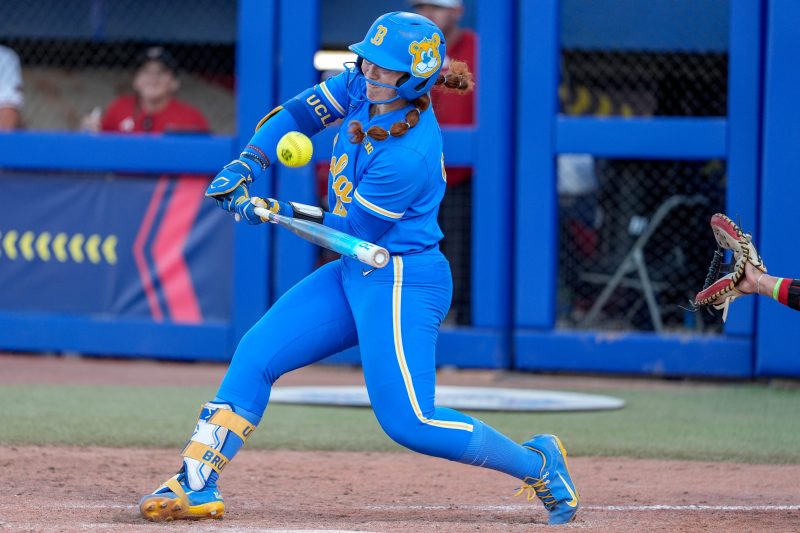
Tennessee softball’s elimination game against UCLA in the 2025 Women’s College World Series on Sunday at Devon Park in Oklahoma City sent fans across the country to a place few would have anticipated when they tuned into the matchup — the NCAA rule book.
With the Lady Vols leading the Bruins 4-2 in the top of the seventh inning with two outs, Megan Grant smacked a two-run, game-tying home run off Tennessee flame-thrower Karlyn Pickens.
What initially appeared to be a straightforward — albeit incredibly consequential — play soon became a subject of controversy.
After rounding third base, Grant headed home, with her teammates waiting there to mob her. Grant, however, did not initially touch home plate and only did so several seconds later after teammate Alexis Ramirez prompted her to do so.
Umpires prompted a lengthy video review, which ultimately resulted in the call on the field being upheld, even though Grant had not originally touched the plate and had been assisted to go back and make contact. However, the play wasn’t reviewable according to Appendix G. The decision sent the game into extra innings.
The ruling led to frustration and outright anger from the Tennessee dugout, but for those watching the game, it created some understandable confusion. What, exactly, is Appendix G?
Here’s a closer look at Appendix G and how it factored into the umpiring crew’s decision in Sunday’s WCWS game between UCLA and Tennessee softball:
What is Appendix G?
Tucked away in the 185-page 2025 NCAA Softball Rule Book is Appendix G, which legislates video review in the sport.
The appendix, which covers two pages in the rule book, details what plays are subject to video review and criteria for using video review.
Appendix G outlines 12 different plays and scenarios that can be reviewed. While there is a section for flagrant and malicious contact, that doesn’t appear to include actions like Ramirez nudging her teammate to ensure she touches home plate.
Here’s a list of the plays subject to video review, according to the NCAA rule book:
- 1. Regarding batted balls (any ball higher than the top of the foul pole when it leaves the field cannot have that aspect reviewed):
- a. Deciding if a batted ball called fair is fair or foul.
- b. Deciding if a batted ball called foul should be a ground-rule double, home run, or hit-by-pitch.
- c. Deciding if a batted ball is or is not a home run.
- 2. Regarding pitched balls at the plate:
- a. Deciding if a pitch ruled a dropped third strike was caught before the ball touched the ground.
- b. Deciding whether a live or dead ball should be changed to a foul ball.
- c. Deciding whether a foul ball should be changed to a foul tip only with no base runners, or if it would result in a third out.
- d. Deciding whether a batter is entitled to an award of first base per Hit Batter (by Pitch) – whether the ball hit the batter, whether the ball was entirely in the batter’s box, whether the batter made an attempt to get out of the way of the pitch when required, and/or whether the batter intentionally tried to get hit by the pitch (see Rule 11.13).
- 3. Spectator interference.
- 4. Obstruction and interference (including collisions).
- 5. Deciding if malicious/flagrant contact occurred. Umpires may initiate this review without requiring a coach’s challenge at any point in the game to ensure student-athlete safety.
- 6. Timing plays (deciding whether a third out is made before the lead base runner touches home plate).
- 7. Force/Tag Play Calls: Plays involving all runners acquiring the base before the defensive player’s attempt to put the runner out at any base.
- 8. Blocked or dead ball/Placement of Runners: Deciding whether a ball not ruled blocked should be ruled blocked, and the proper placement of runners (per the rules/case book) after any blocked or dead ball call.
- 9. A catch or no catch in any situation.
- 10. Runners leaving the base prior to the touch on a fly ball (tagging up), runners missing a base and runners leaving early on a pitch.
Note: The crew chief may not initiate a review of runners leaving early on a pitch. This review is only allowed by a coach’s challenge.
- 11. Any of the listed reviewable items if the action on the field results in a dead ball.
The biggest stories, every morning. Stay up-to-date on all the key sports developments by subscribing to USA TODAY Sports’ newsletter.
